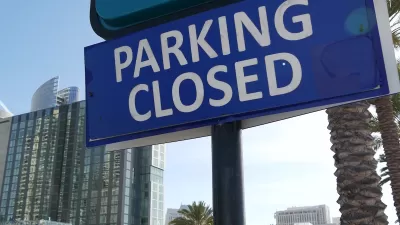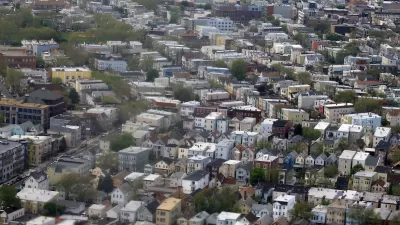Every city has blight – the unsightly, derelict, abandoned, disheveled, and under-utilized spaces of our urban areas. It drains the life out of neighborhoods, drives down the values of surrounding properties, and just looks really bad. So what do cities do about it? Some seize it through eminent domain for redevelopment and others offer incentives to developers to replace it with something better. Many of them, though, don’t do anything at all. But removing blight from a city is not impossible, and it doesn’t have to be an elaborate multi-party scheme or a drawn-out political process. It can be as simple as a coat of paint.
Every city has blight – the unsightly, derelict, abandoned, disheveled, and under-utilized spaces of our urban areas. It drains the life out of neighborhoods, drives down the values of surrounding properties, and just looks really bad. So what do cities do about it? Some seize it through eminent domain for redevelopment and others offer incentives to developers to replace it with something better. Many of them, though, don't do anything at all. But removing blight from a city is not impossible, and it doesn't have to be an elaborate multi-party scheme or a drawn-out political process. It can be as simple as a coat of paint.
In most cases blighted properties are left to rot on their own, below the eyesight of city officials and politicians. But blight out of sight is still blight in the end, and it is a situation that not only feeds on itself, but feeds on its surroundings. Stopping the blight monster from swallowing up entire neighborhoods does require effort, but maybe not as much as some would think.
The borough of Delfshaven in Rotterdam had the very simple idea that if blighted areas were more noticeable they would be more likely to attract the attention of neighbors and the movers and shakers capable of taking the action to remedy them. So they contacted local artist Florentijn Hofman to come up with an idea to make a one blighted and derelict block of the borough more noticeable. Hofman's solution was a new coat of paint – bright sky blue, over the entire building; windows, roofs and all.

The idea was to keep the building in its bright blue state until there was a viable plan to renew or revive the blighted area. And almost instantly, what was once an overlooked and easily ignorable area became one of the most seen places in the city. As Hofman's website describes, "By redecorating this block, which was built in the first years of the 20th century, people start looking again at what was and is there, and maybe think about what they will get in return."

This blue building not only brings people's attention back to a once-forgotten space, but also works to prod the development (or redevelopment) community to take advantage of the existing opportunities in the city. Having a bright blue building screaming at your face every day – whether you're a developer, a planner or a neighbor – would most likely motivate you to see about getting something done.
Other cities should learn from this example, and should start to rethink how they handle (or don't handle) their blighted areas. By creating a situation that is at once a call to action, an unavoidable reminder, and even a tourist attraction, cities can better realize the potential of the blighted spaces they might have otherwise continued to disregard.
UPDATE: Florentijn Hofman recently contacted me to add a little more clarity to this blog post. From Hofman:
"The borough of Delfshaven in Rotterdam asked me to do a wall they wanted to put there to cover the doors of the derelict block. They had the notion of graffiti, and asked me to make a mural with a local graffiti artist. I said 'No!' and came up with this idea. The moral of the story is they wanted to make the area more nice but with an ancient method (graffiti) -- as if that always works. It's a tool they knew. I've given them another tool -- paint the whole block! Now I see it done more and more often in other boroughs of the city."

Planetizen Federal Action Tracker
A weekly monitor of how Trump’s orders and actions are impacting planners and planning in America.

Maui's Vacation Rental Debate Turns Ugly
Verbal attacks, misinformation campaigns and fistfights plague a high-stakes debate to convert thousands of vacation rentals into long-term housing.

Restaurant Patios Were a Pandemic Win — Why Were They so Hard to Keep?
Social distancing requirements and changes in travel patterns prompted cities to pilot new uses for street and sidewalk space. Then it got complicated.

In California Battle of Housing vs. Environment, Housing Just Won
A new state law significantly limits the power of CEQA, an environmental review law that served as a powerful tool for blocking new development.

Boulder Eliminates Parking Minimums Citywide
Officials estimate the cost of building a single underground parking space at up to $100,000.

Orange County, Florida Adopts Largest US “Sprawl Repair” Code
The ‘Orange Code’ seeks to rectify decades of sprawl-inducing, car-oriented development.
Urban Design for Planners 1: Software Tools
This six-course series explores essential urban design concepts using open source software and equips planners with the tools they need to participate fully in the urban design process.
Planning for Universal Design
Learn the tools for implementing Universal Design in planning regulations.
Heyer Gruel & Associates PA
JM Goldson LLC
Custer County Colorado
City of Camden Redevelopment Agency
City of Astoria
Transportation Research & Education Center (TREC) at Portland State University
Jefferson Parish Government
Camden Redevelopment Agency
City of Claremont





























